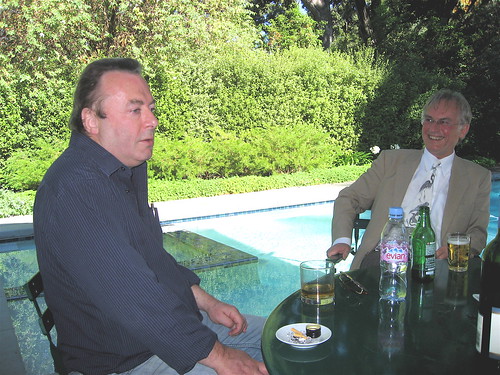Mimetic Foment
Check out these Religion images:
Mimetic Foment

Image by jurvetson
Just got back from a bright dinner with Richard Dawkins at the pad of Christopher Hitchens (left), author of God Is Not Great: How Religion Poisons Everything, currently #2 on NYTimes Bestseller list.
Thanks to David Cowan for organizing the soiree after Dawkins’ talk at Kepler’s.
MacBook Stickers #1

Image by Tom Carmony
Slowly working on "customizing" my white MacBook.
Light Shining in Darkness : Isaiah 60:1-5 at Ely Cathedral

Image by antonychammond
The story of Ely Cathedral begins in Saxon Times with the life of its founder,
St. Etheldreda.
St. EtheldredaEtheldreda (Æthelthryth, Ediltrudis, Audrey) (d.679), queen, foundress and abbess of Ely. She was the daughter of Anna, king of East Anglia, and was born, probably, at Exning, near Newmarket in Suffolk. At an early age she was married (c.652) to Tondberht, ealdorman of the South Gyrwas, but she remained a virgin. On his death, c.655, she retired to the Isle of Ely, her dowry. In 660, for political reasons, she was married to Egfrith, the young king of Northumbria who was then only 15 years old, and several years younger than her. He agreed that she should remain a virgin, as in her previous marriage, but 12 years later he wished their marital relationship to be normal. Etheldreda, advised and aided by Wilfred, bishop of Northumbria, refused. Egfrith offered bribes in vain. Etheldreda left him and became a nun at Coldingham under her aunt Ebbe (672) and founded a double monastery at Ely in 673. (from FARMER, David: The Oxford Dictionary of Saints, 3rd ed. OUP, 1992.)
Etheldreda restored an old church at Ely, reputedly destroyed by Penda, pagan king of the Mercians, and built her monastery on the site of what is now Ely Cathedral. After its restoration in 970 by Ethelwold it became the richest abbey in England except for Glastonbury.
Etheldreda's monastery flourished for 200 years until it was destroyed by the Danes. It was refounded as a Benedictine community in 970.
Etheldreda died c.680 from a tumour on the neck, reputedly as a divine punishment for her vanity in wearing necklaces in her younger days; in reality it was the result of the plague which also killed several of her nuns, many of whom were her sisters or nieces. At St Audrey's Fair necklaces of silk and lace were sold, often of very inferior quality, hence the derivation of the word tawdry from St Audrey.
17 years after her death her body was found to be incorrupt: Wilfred and her physician Cynefrid were among the witnesses. The tumour on her neck, cut by her doctor, was found to be healed. The linen cloths in which her body was wrapped were as fresh as the day she had been buried. Her body was placed in a stone sarcophagus of Roman origin, found at Grantchester and reburied.
For centuries, Etheldreda's shrine was the focus for vast numbers of medieval pilgrims. It was destroyed in 1541, but a slate in the Cathedral marks the spot where it stood, and the 23 June and 17 October are still kept as major festivals in the Cathedral. Some relics are alleged to be in St Etheldreda's Church, Ely Place, London (where the bishops of Ely formerly had their London residence). Her hand, which was discovered in a recusant hiding place near Arundel in 1811, is claimed by St Etheldreda's Roman Catholic church at Ely.
Eternal God,
who bestowed such grace upon your servant Etheldreda
that she gave herself wholly to the life of prayer
and to the service of your true religion:
grant that we, like her,
may so live our lives on earth seeking your kingdom
that by your guiding
we may be joined to the glorious fellowship of your saints; through Jesus Christ our Lord. Amen.
Etheldreda Banner
Miss Yams of Bayswater in 1910Work on the present Cathedral began in the 11th century under the leadership of Abbot Simeon, and the monastic church became a cathedral in 1109 with the Diocese of Ely being carved out of the Diocese of Lincoln. The monastery at Ely was dissolved by Henry VIII in 1539. Ely suffered less than many other monasteries, but even so, statues were destroyed together with carvings and stained glass. St Etheldreda's Shrine was destroyed.
The Cathedral was refounded with a Chapter of eight canons in 1541 as was the Kings School.
Robert Steward, the last Prior of the monastery, became the first Dean.
The first major restoration took place in the 18th Century under James Essex. With the arrival of Dean George Peacock in 1839 a second restoration project began. Together with the architect Sir George Gilbert Scott, he restored the building to its former glory.
A third major restoration project, the most extensive to date, was begun in 1986 and was completed in the year 2000.
If you would like more information on this magnificent cathedral, please visit
www.cathedral.ely.anglican.org/
No comments:
Post a Comment